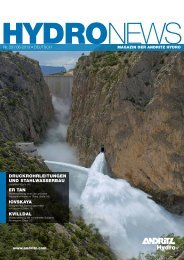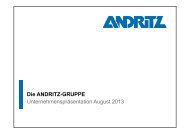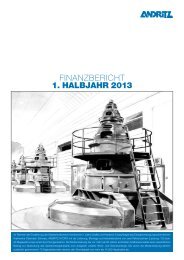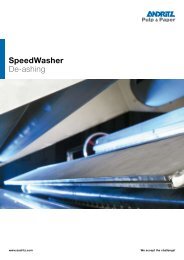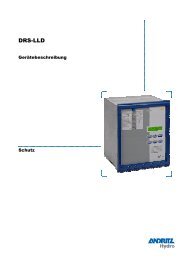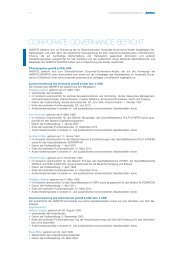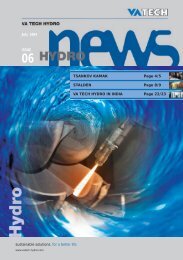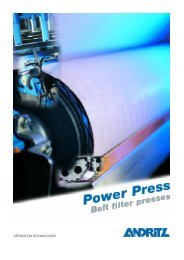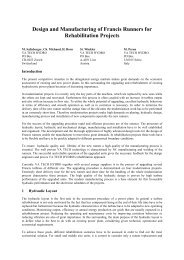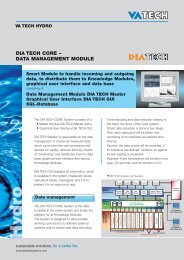FiberSpectrum - ANDRITZ Vertical volute pumps
FiberSpectrum - ANDRITZ Vertical volute pumps
FiberSpectrum - ANDRITZ Vertical volute pumps
Create successful ePaper yourself
Turn your PDF publications into a flip-book with our unique Google optimized e-Paper software.
Stora Enso Hylte<br />
Sludge ...unwanted and unloved?<br />
The processing and disposal of sludge may not be glamorous, but it certainly is necessary. The<br />
European Recovered Paper Council (ERPC) announced that paper recycling was at a record high<br />
in Europe of 63.4% – 58.2 million tonnes of paper and board. This translates to about 3.5 million<br />
tonnes of sludge. Fortunately, Andritz has solutions for sludge handling – and the Hylte Mill in<br />
Sweden is successfully applying Andritz technology.<br />
Stora Enso’s Hylte is a world-class producer<br />
of standard newsprint. The mill<br />
is located beside the Nissan River in a<br />
heavily forested part of Sweden’s<br />
Småland province. With 900 employees,<br />
the mill is the largest private<br />
employer in the community. The Hylte<br />
Mill produces about 800,000 t/a of<br />
newsprint.<br />
Furnish for the mill’s four paper machines<br />
comes from a deinking (DIP)<br />
plant producing 390,000 t/a deinked<br />
pulp, a TMP plant producing<br />
250,000 t/a, and a groundwood mill<br />
producing 160,000 t/a.<br />
This year, the Hylte Mill is celebrating<br />
its first 100 years of operation. Arne<br />
Sundkvist, Strategic Planner at the<br />
mill, wants to ensure they are well<br />
positioned for many years in the future.<br />
Maintaining close contact with customers<br />
provides Sundkvist good insight<br />
into emerging trends and changing<br />
needs. “A daily newspaper is a perishable<br />
commodity,” Sundkvist says.<br />
“We produce uniformly high quality<br />
newsprint products at this mill and are<br />
continuously working to ensure that the<br />
stability of our production is constantly<br />
improving. We upgrade and rebuild the<br />
mill continuously to maintain our high<br />
product standards.”<br />
The upgrades extend all the way<br />
through the value chain – including the<br />
mill’s by-products and waste products.<br />
| <strong>FiberSpectrum</strong> 16 – 02/2007<br />
DIP main source of fiber<br />
“The raw material for our DIP plant<br />
comes from old newspapers – daily and<br />
weekly newspapers collected mainly<br />
from the Nordic countries,” says Tommy<br />
Johansson, Deinking Technician.<br />
Johansson has been a mill employee<br />
since 1977, and has worked in deinking<br />
since 1984.<br />
There are actually two lines producing<br />
390,000 tonnes per year of deinked<br />
pulp. “Yield” is the term used by paper<br />
manufacturers for the amount of usable<br />
fiber rendered after the cleaning and<br />
deinking processes remove contaminants,<br />
explains Mauri Kurkimäki, Operating<br />
Technician in the deinking plant.<br />
▼ Tommy Johansson, Deinking Technician (left), Arne Sundkvist, Strategic Planner at Hylte Mill (center) and Artur Salawa, Product Engineer for Dewatering and<br />
Bleaching from Andritz<br />
“The yield we get from old newspapers<br />
at the Hylte Mill is about 85%, which<br />
is consistent with industry standards,”<br />
Kurkimäki says. This means that 15%<br />
of the incoming volume must pass<br />
through the facility as rejected material,<br />
or sludge.”<br />
The sludge from the two DIP-lines is<br />
dewatered on three common gravity<br />
tables followed by screw presses. The<br />
Andritz gravity table is used due to its<br />
ability to gently pre-thicken very dilute<br />
sludge suspensions (3.5% in the case<br />
of the Hylte Mill). This efficient prethickening<br />
increases the capacity of<br />
the Andritz sludge screw press. The<br />
original equipment for sludge handling<br />
Line 1 was installed in 1994, for Line 2<br />
in 1995, and for Line 3 in 1997.<br />
More production, more sludge<br />
The Hylte Mill wanted to increase its<br />
production of newsprint, which meant<br />
an increase in DIP production as well.<br />
A new flotation system was installed<br />
and the next requirement was to rebuild<br />
the existing sludge handling equipment<br />
to increase production by about 10%.<br />
“While our employees are responsible<br />
for providing input regarding increasing<br />
efficiency and maintenance, in order<br />
for us to have a truly productive and<br />
environmentally safe mill, we need the<br />
expertise from outside suppliers like<br />
Andritz,” Sundkvist says. “Most often,<br />
we rely upon the expertise of individuals<br />
within that network of suppliers.”<br />
“This is when we began discussions<br />
with Artur Salawa,” Kurkimäki says.<br />
Salawa is a Product Engineer for De-<br />
▲The Hylte Mill celebrates its 100th year of operations in 2007. Today, it produces 800,000 t/a of newsprint.<br />
▼ The challenge: optimized dimensioning of existing equipment in order to handle changing sludge<br />
characteristics and to achieve higher dryness – using the same basic equipment. Andritz and mill<br />
personnel met the challenge by extending and upgrading the three existing gravity tables.<br />
13



